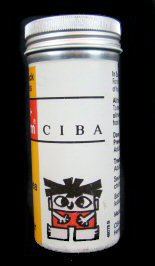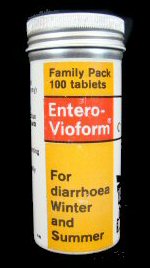Maryland Archaeological Conservation Laboratory
Main_Content
Curator's Choice 2009
Artifact of an Archaeologist
April 2009
By Erin Wingfield, MAC Lab Collections Assistant
This unusual canister was found in a brown paper bag containing various
prehistoric artifacts from an archaeological site in Maryland. Inside
this container were smaller pieces of bone and shell. This container
was used to hold and protect these easily damaged artifacts. The
archaeologist probably used this medicine before utilizing the empty
container for holding artifacts.
 |
|

|
The container would have originally contained an oral diarrhea medicine
called Entero-vioform. On the front of the container a little cartoon
figure is shown holding his tummy, implying an upset stomach or
intestinal problem. Writing on the container reads, "For Diarrhoea
Winter and Summer…. For the prevention and treatment of holiday
diarrhoea (holiday tummy)". This implies that not only was diarrhea
attributed to food poisoning and general sickness but also overindulgence
during holiday feasting. Entero-vioform was also commonly used to
deal with traveler's diarrhea from eating bad or contaminated food
or water (Dukes 1998:74). This product was originally produced in
Great Britain and may have been shipped to the United States or
purchased overseas by the archaeologist.
Entero-viof
orm was widely promoted throughout the world as a safe
and effective way to prevent and cure diarrhea. But in 1939, animal
testing revealed the drug used in this medicine produced epilepsy
and neurological damage. However, none of this research was published
and the drug continued to stay on the market (Dukes 1998:74). Beginning
in the 1950s, cases of a new disorder later named subacute myelo-optic
neuropathy (SMON) appeared worldwide. This condition produced degenerative
and in some cases irreversible neurological damage leading to blindness
and paralysis. The most notable cases appeared in Japan where over
20,000 individuals were afflicted with SMON (Coburn 1998:486). As
a result, the medicine was banned in several countries, which led
to a large decrease in cases of SMON (Dukes 1998:74). Even after
this outcome, the Ciba Company continued to produce Entero-vioform
until 1985 when a public campaign forced it off the shelves (Coburn
1998:486).
Many interesting artifacts come to the Maryland Archaeological Conservation
Lab looking for a home. Archaeologists study these objects to learn
about humans in the past and in turn share this knowledge with the
public. Archaeologists themselves also leave behind their own artifacts.
Examining the ordinary containers used to package and protect artifacts
for storage allows us to learn more about the archaeologists themselves.
Through this small container, we have learned the archaeologist
had a bad case of diarrhea, possibly from traveling or overeating,
and was able to purchase this medicine for relief. It is currently
unknown if the archaeologist developed any neurological disorders
as a result.
--- Happy April Fools!
| References |
|
| Coburn, David, Carl D'Arcy, and George Murray Torrance |
| 1998 |
Health and Canadian Society: Sociological Perspectives. University of Toronto Press, Canada. |
|
| Dukes, Graham, Mark Mildred, and Barbara Swartz |
| 1998 |
Responsibility for Drug Induced Injury: A Reference Book for Lawyers, the Health Professions, and Manufacturers. IOS Press, Washington D.C. |
|